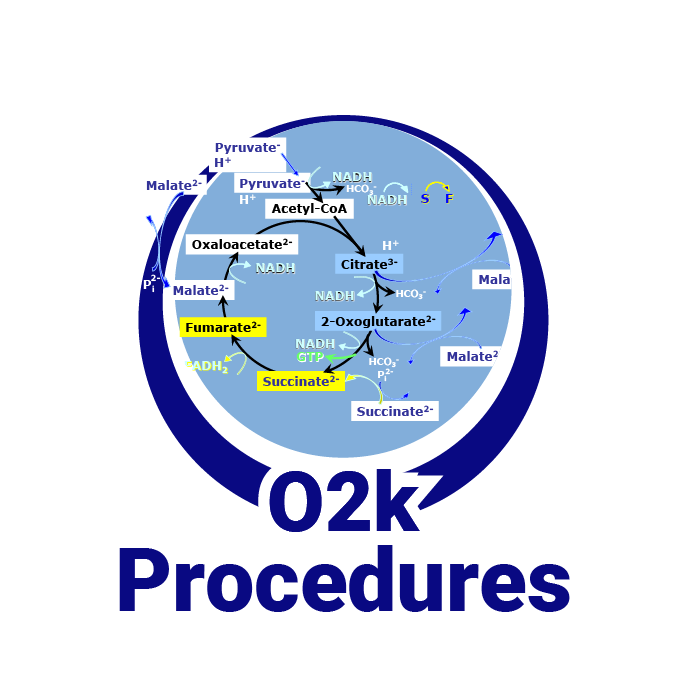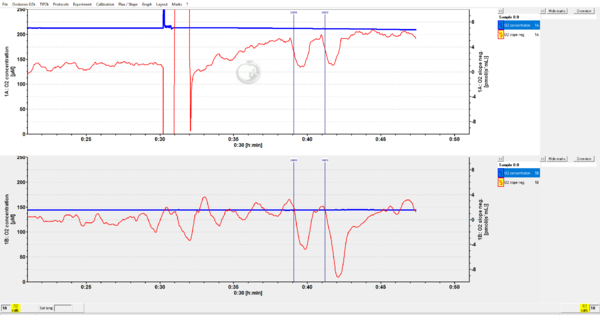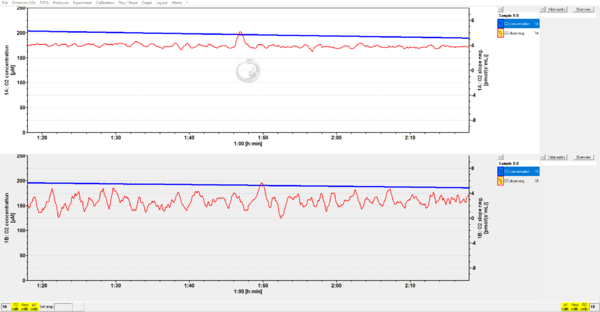 |
Talk:Oxygen signal |
Description
The oxygen signal of the Oroboros O2k is transmitted from the electrochemical polarographic oxygen sensor (OroboPOS) for each of the two O2k-chambers to DatLab. The primary signal (raw signal) is a current [µA] displayed in the bottom status bar in DatLab 8. DatLab 7 displays the raw signal as a voltage [V]. It is calibrated in SI units for amount of substance concentration [µmol·L-1 or µM].
Reference: MiPNet06.03 POS-calibration-SOP
Oxygen signal without calibration
- Even before oxygen calibration in DatLab, the oxygen signal is shown in units of O2 concentration [µM], but the numbers shown as a default are different from the real O2 concentration. Yellow indicator fields (called 'O2 calib.' in DatLab 7 and 'O2' in DatLab 8) in the bottom right and bottom left corner of the experiment window remind the user to perform the oxygen calibration.
- The non-calibrated default values are calculated on the basis of the following settings, which apply before any calibration was performed in DatLab, or when the Reset to defaults button is clicked in the O2 calibration window:
- POS signal recorded; R1 = 2 (at air saturation) the unit is [V] in DatLab 7 and [µA] in DatLab 8
- POS signal recorded; R0 = 0 (at zero oxygen concentration) the unit is [V] in DatLab 7 and [µA] in DatLab 8
- Temperature = 37.00 °C
- Barometric pressure, pb = 100 kPa
- O2 solbility factor of medium, FM = 1.00
- These default settings result in a calculated O2 concentration at air saturation of 207.32 µM.
- The non-calibrated default values are calculated on the basis of the following settings, which apply before any calibration was performed in DatLab, or when the Reset to defaults button is clicked in the O2 calibration window:
Oxygen signal after calibration
- The raw signal from an open O2k chamber at air saturation depends on experimental temperature, barometric pressure (depending on altitude and weather), and the sensitivity of the individual POS. The raw signal is converted to oxygen concentration [µM or nmol/mL] by calibration of the POS.
- After performing an oxygen calibration in DatLab and pressing Calibrate and copy to clipboard in DatLab 7 or Apply / OK in DatLab 8, the blue plot in the graph corresponds to the actual oxygen concentration in the O2k chamber. In DatLab 7 the calibration settings are saved for future usage, DatLab 8 asks the user if calibration settings should be set as default for future usage or apply to the ongoing experiment only.
- Yellow indicator fields ('O2 calib.' in DatLab 7 and 'O2' in DatLab 8) at the bottom of the experiment window remind the user that the previously-set default calibration is applied (the yellow color indicates that the latter may not be adequate for the curring experiment). After opening the O2 calibration window and pressing Calibrate and copy to clipboard in DatLab 7 or Apply / OK in DatLab 8, the color will change to green ('O2 calib.' in DatLab 7 and 'O2' in DatLab 8), indicating that the user confirmed the calibration.
- As soon as the settings applied for calibration (like temperature, barometric pressure, solubility factor of the medium,...) change, the calibration has to be repeated. Usually, that means that recalibration is necessary on a daily basis.
Raw signal
- The raw signal of the polarographic oxygen sensor (POS) depends on the Gain setting. The default is Gain 1 in O2k-Series G and higher (Gain 2 was default in previous O2k-Series). Changing the Gain setting is neither necessary nor recommended in O2k-Series G and higher. At Gain 1 the maximum signal is 10 volt (10 V). Above 9.99 V, the amplifier is in the saturation range, the apparent signal will remain constant at this value, and the slope will appear to be zero. Changing the gain would require a separate calibration of the oxygen signal.
Raw signal nomenclature
- R1 is the raw signal from an 'open chamber', where the O2 concentration in the medium is allowed to equilibrate with atmospheric O2 concentration.
- R0 is the raw signal from an 'closed chamber' that is isolated from atmospheric oxygen and where residual O2 concentration is depleted chemically or by an O2 consuming biological sample.
- See Raw_signal_of_the_oxygen_sensor for typical values and where to find them.
Problems and solutions
- R1 is too high
-
- first of all R0 should be checked. A high zero current will also give a correspondingly higher current at air saturation.
- If R0 is too high
-
- the problem has to be further located by switching components. Typically the problem will be located either on the POS or on the POS connector (check here instructions to clean and dry the OroboPOS-Connector).
- If R0 is ok, consider the following potential reasons for changes in R1
-
- The stirrer speed (rpm) may have been changed, or the stirrer may have been left in the off mode. - Re-set the stirrer speed and re-calibrate.
- The gain setting may have been changed. - Compare calibration values at identical gain settings.
- The block temperature may have been changed. - Compare calibration values at identical temperatures.
- R1 is similar, but the oxygen calibration factor of the medium, FM.
- The barometric pressure has changed (e.g., experiments carried out at high altitude).
- first of all R0 should be checked. A high zero current will also give a correspondingly higher current at air saturation.
- Unexpected R1 values after application of a new membrane
-
- Lower R1: The membrane thickness may have changed, possibly by inadvertently using two superimposed membranes.
- Lower R1: The membrane may have wrinkles in the area of the cathode.
- Lower R1: The sensor cap may have not been applied properly in the centre, now partially blocking the cathode.
- Higher R1: The membrane may have been overstretched, or a thinner membrane is used.
- Unexpected R1 values after re-assembly of the O2k-chamber
-
- Lower R1: The chamber may have been improperly positioned, with the blue POS holder (on the left or right side of the copper block) screwed too far into the chamber housing. This would allow only partial contact between the stirred medium and the cathode. - Follow the O2k-Start instructions (MiPNet22.11 O2k-FluoRespirometer manual) to insert the chamber properly.
- The electrolyte in the POS may have partially dried out. - Apply a new membrane, following POS-Service instructions: MiPNet28.10 POS-service.
- Raw signal stability
-
- The stability of the oxygen signal is evaluated by the (negative) uncorrected slope over time. The slope of a stable sensor should be less than ± 1 pmol·s-1·mL-1 in a 2-mL O2k chamber.
- If there is a drift of R1 or R0 or both over short or long periods of time, follow the SOP instructions: MiPNet06.03 POS-calibration-SOP.
Keywords: Oxygen signal
Troubleshooting
Anonymous user
Question:
Q1: The Oxygen Concentration couldn't go down while I tried zero oxygen calibration. No matter how much solution I added, the oxygen concentration still remain the same. I reassembled, but it still keeps the same. The data is attached.
Q2: The chamber B's oxygen slope is not stable. This is a new problem I have never seen. Please see the attachment.(2019-04-26)
Q3. The maximum Oxygen concentration of another Oroboros O2k is only about 140 μM. I don't how to increase the starting point of oxygen concentration.
Answer:
A1: I suspect that the dithionite solution was not correctly prepared or not fresh. Dithionite loses activity quite fast, so you need to make it freshly. Please check this site: http://bioblast.at/index.php/Dithionite
A2: While there is a difference between chambers A and B, the stability of the signal is still within the acceptable range of noise given by the specifications of the instrument, see: Oxygen_sensor_test.
A3: You may simply need to calibrate, please see here: http://wiki.oroboros.at/index.php/O2_calibration_-_DatLab
MitoPedia methods: Respirometry
MitoPedia:
DatLab,
Oroboros Open Support








